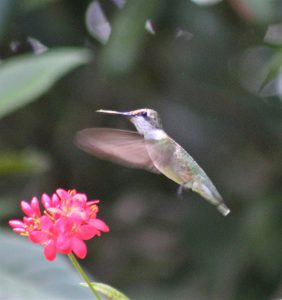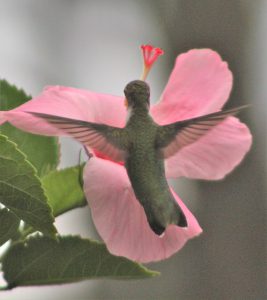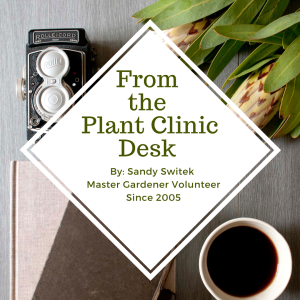Migratory Birds in Florida
Saturday, May 14, 2022, is the World Migratory Bird Day. Created by the Smithsonian Migratory Bird Center in 1993, it is a day to celebrate and learn about migratory birds. For more information you can visit World Migratory Bird Day | in the Americas
Florida has lots of migratory birds that pass through twice a year, using what is called the Atlantic Flyway. But our area also has seasonal residents that only stay here part of the year and then migrate themselves.
Seasonal Residents – Ruby Throated Hummingbird
One of the most beloved part time residents is the Ruby Throated Hummingbird. It is the only hummingbird which breeds in Florida. Usually arriving in our area by early March, the birds stay through September, leaving by October.
So where do these tiny birds go, and how long does it take?
Most of our hummers are thought to end up in Mexico, Central America, or even South America. If they follow the coast, it is 1400 miles (about half the width of the United States)) from here to Mexico. At a speed of 30 miles per hour, this takes them 45 hours (about 2 days) of flying time. Some may fly only a few hours a day, stopping at the same refueling spots and using the same nectar plants each year. Other Ruby Throats are more impatient to get where they are going and fly directly across the Gulf of Mexico to their destination. This is an incredible 500 to 600 miles, done in 18 to 22 hours, nonstop. Each bird is on its own, as they do not migrate in flocks. Males leave a week or two before females and young birds.
Where do the birds get the energy to take such a long trip?
Hummingbirds try to take on extra weight and body fat before the trip, in order to have the strength to get there. Extra insects and nectar are eaten for weeks before the trip.
If you have a feeder, do not take it down when you think it is time for the birds to leave. Experts do not think that the feeders affect their decision about when to depart. This means that taking the feeders down can deprive the birds of some extra calories before their trip. If you see hummingbirds here past the departure dates, it is thought that those birds are either too old or too injured to make the trip. However, in South Florida, there are supposedly a few healthy birds that just stay also.
In any case, the same birds which flew away from here in October usually return to the same spots again in the spring. Apparently, they remember where every flower was, so if something dies, it would be good to replace it.
What kind of plants do they like?
Bright tubular shaped blooms really attract hummingbirds, but the birds are not limited to red or any certain color or shape. They will experiment and decide what they like from your garden. Some favorites include bottlebrush, firebush, fire spike, shrimp plant, crape myrtle, hibiscus, impatiens, red spiral ginger, and even variegated ginger blooms. Others include salvia, cardinal flower, red basil, butterfly milkweed, thistle, and trumpet vine. Trees and large shrubs will give hummers a place to hunt for insects as well. I have seen them eating insects off my crape myrtles and oak trees.
Besides that, trees are used for nesting, and my birds always choose oaks. Tiny walnut size nests are built about 20 feet above the ground. These are quite charming, as the plant fibers are adorned with moss and lichen on the outside and are bound together with spider webs. The 2 pea size eggs hatch in about 20 days (about 3 weeks). Chicks live in the nest for 4 weeks, eating insects the parents bring to them.
Their routines
During a normal day, a hummingbird must eat some insects and drink nectar from hundreds of blossoms a day to survive. They feed every 10 or 15 minutes, from dawn to dusk. At night they drop their body temperature and heart rate to survive without food.
However, during the day, hummingbirds can become quite acrobatic. They usually suspend themselves in midair to drink nectar, but they can also do other feats. They can fly backwards, zoom straight up, and fly upside down. Wings beat anywhere from 50 to 200 times per second.
What about hummingbird feeders?
- While feeders should not be the main source of food for hummingbirds, they can help to supplement the diet.
- The recipe consists of one-part granulated sugar and 4 parts water. It should be boiled to dissolve it well.
- Do not use red food coloring.
- Do not use extra sugar or honey or artificial sweeteners, these things can be lethal.
- Avoid direct sunlight, as the heat can encourage bacterial growth.
- Rain can dilute the solution.
- Change the mixture every 3-5 days to avoid contamination.
- Clean the feeder with water and white vinegar each time the mixture is changed. Do not use soap or bleach.
Plant selection is important
Just remember that the birds’ natural food contains more nutrients than just sugar, so planting some flowering shrubs, trees, and other nectar plants is a better idea. In my yard, they have always preferred real nectar. Once they discover your nectar supply, they will likely remember those flowers and decide to come back and raise another family next year!
And if you get lucky, a hummer may someday suspend itself in front of you on occasions when you have worn a bright colored hat or shirt. What a pleasant view of them for a moment, before they zoom away.
Hummingbirds are not easy to photograph, and my husband and I have not done too well at it. But anyway, here are 2. Females do not have the brilliant red iridescence on the throat.
 Female checking out plumeria – John Switek
Female checking out plumeria – John Switek
 Going for hibiscus – Sandi Switek
Going for hibiscus – Sandi Switek
Need more information:
For more information about Florida Friendly Plants and attracting wildlife you can email me at epabon5@ufl.edu or like us to learn about new classes or events at Gardening in Central Florida
By: Sandy Switek since 2005 and Eva Maria Pabon Residential Horticulture Agent
Do you want to read more about gardening? Follow our blog Eva Pabon, Author at UF/IFAS Extension Osceola County (ufl.edu)
 2
2

